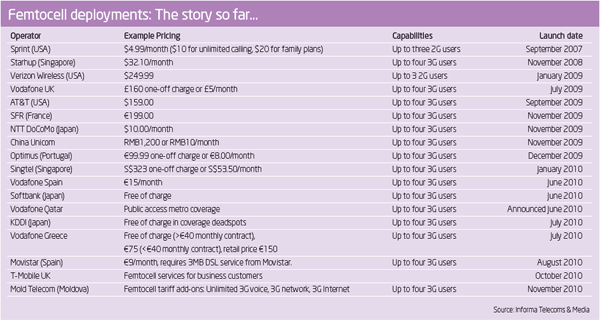Baby Boom
With 18 operators now having deployed more than 1.7 million femtocells, the baby of the infrastructure sectors is finding its feet. And like all babies, it’s ready to grow, as it looks to move away from its original model of miniaturisation.
February 28, 2011

Femtocells are getting bigger. This is true both in the sense that the market as a whole is gathering momentum and in the more literal sense that the sector is moving away from the central tenet of miniaturisation on which it first made its stand.
The femtocell was brought to market with a very simple message. Here was a base station small enough to fit in the home of the consumer, which could be plugged into their fixed line connection, immediately giving them outstanding indoor cellular coverage, backhauled through their own resource. It certainly spoke to a need in many markets, where coverage in the home is unreliable at best.
The toughest question raised by the femtocell sales pitch was how operators might encourage users to buy their own access point, while simultaneously running advertising campaigns trumpeting the quality and coverage of their macro network.
The toughest question raised by the technology, meanwhile, was how it could be guaranteed that these little home networks, which operate in licensed, carrier spectrum, could be kept from interfering with the wider network beyond the walls.
This potential “show stopper”, as Andy Tiller, VP of product marketing at femto pioneer IP Access describes it, has, he says, been dealt with. Femtocells have been proven workable by the deployments seen so far. And on the marketing side, he says, a mix of strategies have nudged the devices into users’ homes. Some operators give them away free to users in patchy coverage areas, others charge customers $150/unit, for example.
Whichever way the products have been shifted, it is the original femto proposition that has generated the bulk of sales recorded to date. Informa estimates that there were 1.7 million femtocell access points deployed globally by the end of Q4 2010. Tier-one operators are on board; Sprint, AT&T and Verizon in the US, Softbank, KDDI and NTT DoCoMo in Japan and Vodafone and Telefónica in Europe have all lent credence to the femtocell story. There were 18 commercial femtocell deployments worldwide by the end of 2010, with a further 30 deployment commitments.
The femtocell sector remains small, like its products, but the companies that operate within it are eyeing bigger things…
Evidence of the perceived opportunity in the femto space is also to be found among the vendor community. It’s a popular observation in the sector that, thanks to the volume of its femtocell shipments, Cisco now has more base stations deployed in the US than any other vendor. Broadcom, one of the biggest vendors in the silicon space, bought femto player Percello in 2010, while Alcatel Lucent and Huawei are the two biggest names from the macro network supply side looking to make their mark in this area.
The femtocell sector remains small, like its products, but the companies that operate within it are eyeing bigger things. Specifically they are bidding to establish femtocells as a solution for enterprise, rural and metro deployments, looking to take a slice out of the traditional infrastructure market. And so the term ‘femtocell’ is being quietly phased out. Instead, a more general classification has come into parlance: ‘small cells’.
The deployment of an abundance of small cells is the only way to relieve the coverage and capacity pressures congesting the macro network, say players in this space. And only by scaling up comparatively low cost technology like femtocells can these small cells be manufactured in sufficient volumes while remaining economically viable. The self organising nature of femtocells is also pitched as a big win for these small cell deployments, taking the burden of managing a vast number of new cells away.
A confrontation may be in the offing, though. If the femto sector scales up to metro levels, it is going to bump up against the traditional infrastructure supply side which, the companies mentioned above aside, are holding back from the small cell space.
Andy Tiller, SVP product management at IP access, says: “You’ve got this sort of battleground emerging at enterprise and public access metro level environments where operators like the idea of scaling up the femtocell because it uses cheap IP backhaul, the cost of the kit is low and it offloads the RNCs. On the other hand you’ve got the macro vendors pushing down into that space, arguing that with their traditional architectures you get the benefits of soft handover, and other things that femtos can’t do. The two sides are converging on the metro network level.”
There is a conciliatory tone to much of what the femto specialists say, however, with the familiar ‘complementary not competitive’ industry mantra being applied by some spokespeople. Alcatel Lucent, which has a legacy in the macro network and an enthusiasm for the newer, small cell approach, has a foot in each camp, and so a vested interest in both levels of network technology continuing to flourish.
“We’re now thinking about whether this technology could be absorbed into a city for areas like outdoor coverage hotspots,” says Yannick Dupuch, director of the small cell business unit at Alcatel Lucent. “We’re trying to balance these technologies, which are low cost, with a more expensive solution coming from the macro environment which is more costly, but with a higher level of performance.
And we believe there is room on the market for these two types of approach, depending on the applications and the budget of our customer.” The femto sector sees small cells as a great way of beefing out existing 3G coverage, for example. “What I think we’ll see is large, preplanned manual cells, with huge numbers of intelligent cells of various sizes underneath,” says Keith Day, vice president of marketing at sector specialist Ubiquisys, which supplies femtocells to Softbank in Japan. “Softbank are looking at putting 40 small cells outside for every large base station in the network,” he says.
Femtocell solutions for the enterprise are a logical extension of the initial, domestic coverage model with which products were first introduced. This is an area into which IP Access, Ubiquisys and Alcatel Lucent are all pushing, with end-to-end miniature, selfconfiguring networks for indoor office use that are kept distinct from the network beyond the office walls.
But bringing the technology to metro hotspots or rural areas will not be without significant challenges. As Andy Tiller says, residential grade femtocells would fail in a public access environment because they could not be properly managed. “The industry is being a little naïve in suggesting that route,” he says.
Tiller’s opposite number at Ubiquisys concedes that integrating scaled-up femto technology into the macro network is probably the greatest challenge that the sector faces. “We have to work out the boundaries. Where do the cells fit in with the topology of a planned network? We don’t know the answer to that, yet,” Day says.
The other problem he identifies is processing power. The intelligence built into the products as they’re being scaled up requires a huge amount of processing power. Historically mobile has been about processing at the centre, Day says but increasingly it will be focused on processing at the edge, which will create new demands on processing power.
Alcatel Lucent’s Dupuch argues that the silicon vendors in the femto space are more than equal to the task ahead of them. “Up until recently we were only able to do four users per femtocell and you were limited to 7Mbps,” he says. “This year we’ll do 32 users and 21Mbps. In the next two years you’ll see more drastic improvements of the processing power and then you can add much more complexity.”
Dupuch attributes these advances in part to the increasing enthusiasm of silicon vendors for the femto sector. Broadcom’s arrival through the Percello purchase meant it joined arch rival Qualcomm in the space; Qualcomm is an investor in IP Access. Sector specialist Picochip is the incumbent silicon provider for femtocells and a key partner for IP Access, Ubiquisys and Alcatel Lucent but Dupuch says that his firm is running RFQs with other vendors “to make sure that we have the right partner and make sure that we are still going to be very competitive.”
Picochip, for its own part, is among the most bullish players in the space. Rupert Baines, the firm’s vice president of marketing, is predicting a sea-change in the industry, brought about by explosive growth in the small cell space. Like his fellow femto players, Baines stresses the requirement that these myriad small cells be made extremely cheaply, something which traditional infrastructure vendors will not be able to manage, he says.
Most base stations from traditional vendors, Baines says, are designed to be made in small quantities, using custom components and custom silicon and are necessarily expensive. He draws a parallel with the computer industry of the late 1970s, when computers were high cost, low volume products, made with bespoke software and components. When Intel microprocessors came along, allowing for the mass production of units designed for the home, the previous stable of vendors like Data General, Unisys and IBM found themselves in “a world of hurt,” he said.
The same will happen with the base station manufacturing business, Baines predicts. “Because of people like us, and Qualcomm and Broadcom copying us, you can now make base stations cheaply using standard components and standard software,” he says. “I’m expecting the same kind of fallout in this industry as there was in the computer industry.” Baines doesn’t name names, but suggests that some leading vendors are going to endure dramatic downturns in fortunes, and are currently burying their heads in the sand.
“Look at how aggressively Huawei and Alcatel Lucent are getting into this,” he says. “Look at what John Chambers [of Cisco] says about why they are doing femtocells. Denial is not just a river in Egypt.”
Clearly the firm with the most to lose if these kind of predictions have any substance to them is Ericsson. “I don’t think Ericsson felt threatened by residential femtocells,” says IP Access’ Andy Tiller. “After all, that’s not its business. But when the femto industry begins to move into metro and public access in particular—railways and hotels, for example, where a microcell might previously have done the job, that starts to become quite interesting and disruptive.”
How the incumbent infrastructure vendors respond remains to be seen. But Ericsson, and to a lesser extent Nokia Siemens, which has a femto gateway but no access point offering, are taking a more observational role for the time being. With pioneering companies like Ubiquisys and IP Access still relatively small, an acquisition cannot be ruled out, and the next two years could prove to be defining ones for the small cell network model.

femto-story
Read more about:
DiscussionAbout the Author(s)
You May Also Like








.png?width=300&auto=webp&quality=80&disable=upscale)


_1.jpg?width=300&auto=webp&quality=80&disable=upscale)


.png?width=800&auto=webp&quality=80&disable=upscale)